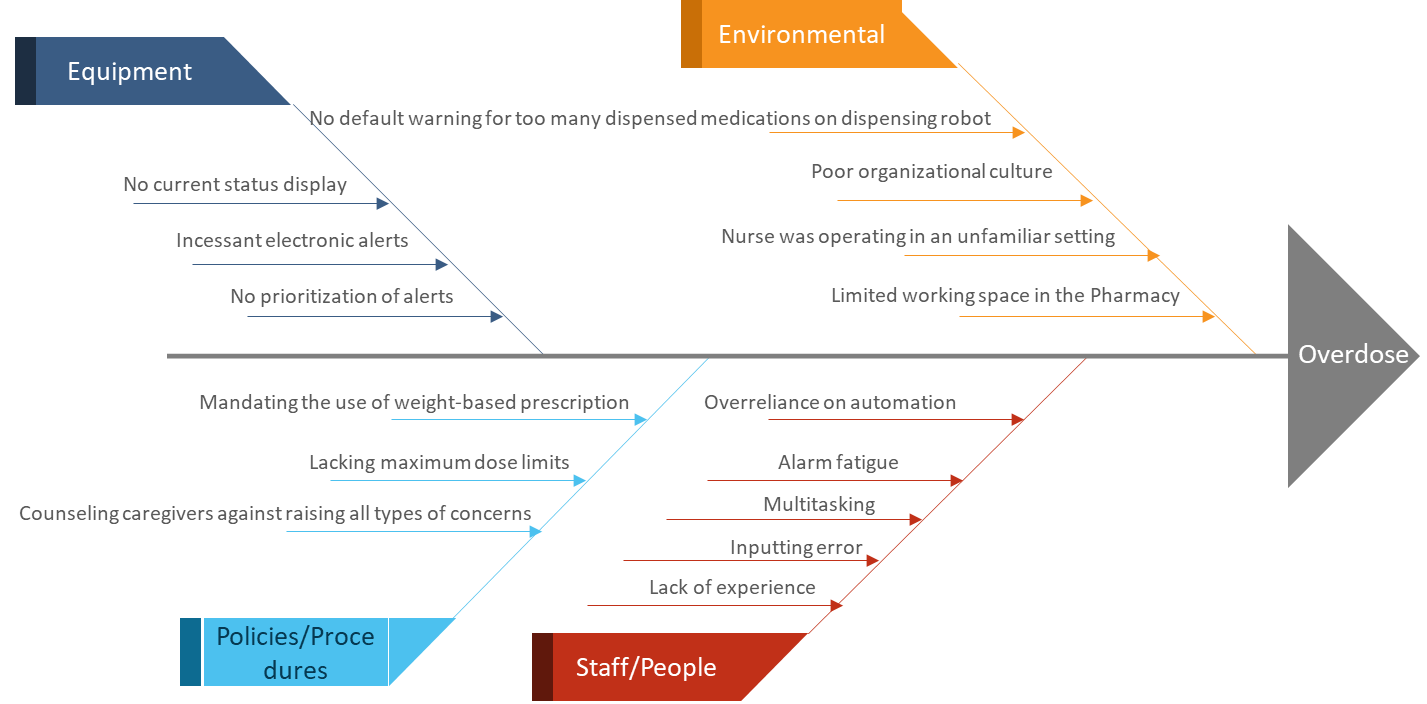The sentinel event under analysis involved a 16-year-old patient admitted to The University of California, San Francisco Medical Center (UCSF) for complications due to NEMO syndrome. The incident was a significant overdose of the antibiotic Septra. Instead of receiving the recommended daily dose of two pills, the patient received 38 and a half tablets. The error resulted from a systemic malfunction attributed to different factors discussed below.
The following is the resultant sentinel event chart that identifies the fault modes associated with the case:

A root cause analysis (RCA) revealed four cause categories: Equipment, Environmental, Policies/Procedures, and Staff/People. The fault modes in the equipment category included incessant electronic alerts, lack of alert prioritization, and lack of current status display. The system output too many alerts and physicians learnt to ignore them, even crucial ones like in Garcia’s case. The attending physician was alerted about a potential overdose, but she had grown accustomed to unnecessary alerts from the system, so she ignored this one. The system also displayed all alerts the same without any differentiation between significant and mild medication errors. As such, the resident could not tell that this particular alert was critical. Finally, the system did not tell what mode it was in, whether ‘milligrams’ or ‘milligrams/kg’, to keep the doctor from making an input error.
Under environmental factors, the dispensing robot was not programmed to warn about too many dispensed medications, an error a human could have caught. The hospital’s poor organizational culture discouraged low-level employees from raising alerts on unclear issues. This is why the nurse could not seek clarification on the number of pills she was about to administer. The nurse was operating in a setting she was not used to, keeping her from seeking guidance and direction when she needed it. Finally, the small and crowded satellite pharmacy prevented the pharmacist from identifying the dosage error because of constant interruptions.
On the people/staff factors, the physician was a new resident and lacked experience using the system she could have drawn from to catch the error in time. The same was true for the nurse who had only been working in the institution for a little over a year, so she had limited exposure to what to do to get in touch with an individual that could offer further directives. She also had an overreliance on automation and did not think the system was suspect to error. All employees involved were subject to alarm fatigue exacerbated by being responsible for multiple tasks. The physician made an inputting error for failing to notice the system’s mode at that time.
The institution’s policies/procedures also played a part in the event. The policy mandated the use of weight-based prescriptions even when physicians knew the correct weight in milligrams. The administration also failed to set the maximum dose limits in the system, a check that could have caught the error. They also counselled nurses to refrain from interrupting senior nurses when they were working, which kept the nurse from seeking advice on the dosage she was about to administer.
The institute can prevent this event from occurring in the future by a set of measures. The institution should revise its policy on weight-based prescriptions and allow physicians to use milligrams whenever possible. The number of system alerts should also be trimmed to only the most essential to keep medical professionals from alert fatigue (Joseph et al., 2021). The system should also include a limit on the number of prescriptions per dosage. Finally, the hospital should create a culture where employees at all levels are encouraged to raise alarms when concerned about any part of the process and be skeptical about unusual system orders and prescriptions.
Reference
Joseph, A. L., Borycki, E. M., & Kushniruk, A. W. (2021). Alert fatigue and errors caused by technology: A scoping review and introduction to the flow of cognitive processing model. Knowledge Management & E-Learning: An International Journal, 13(4), 500-521. Web.